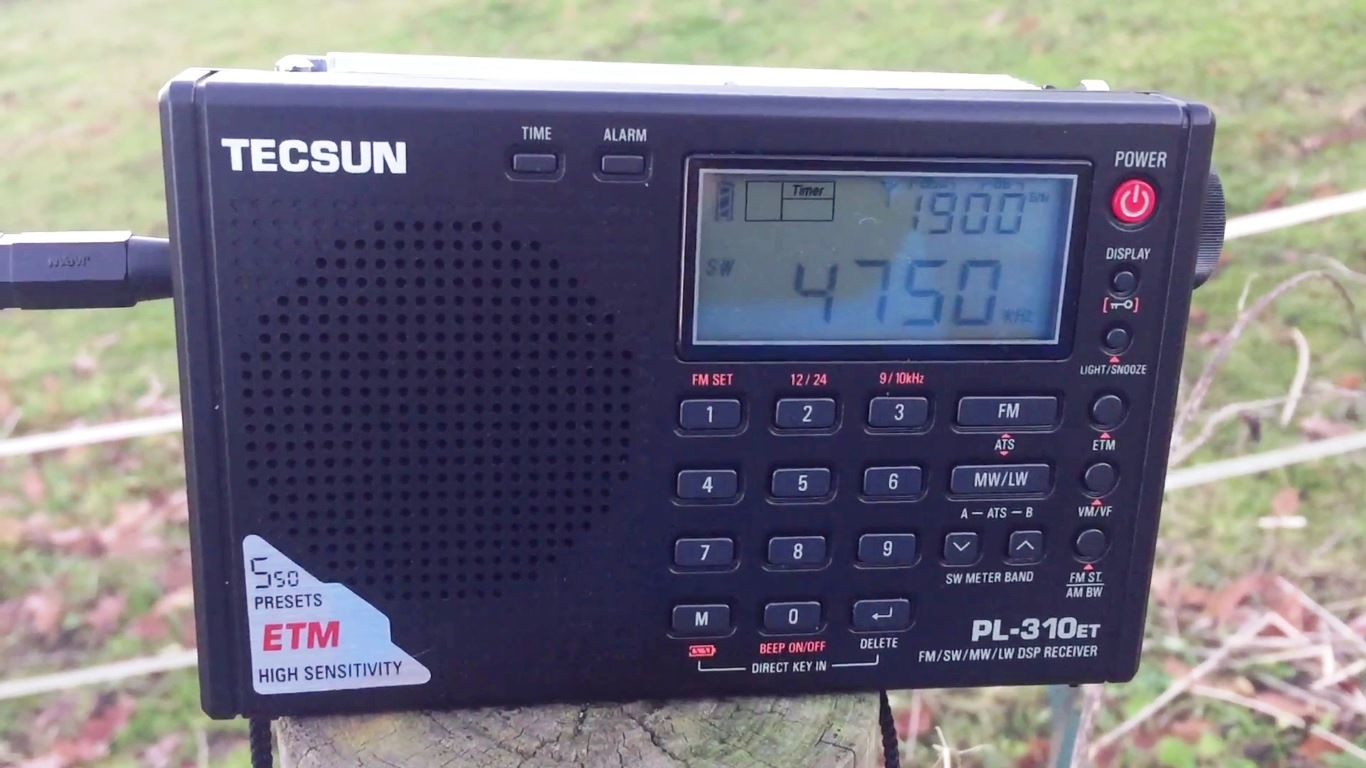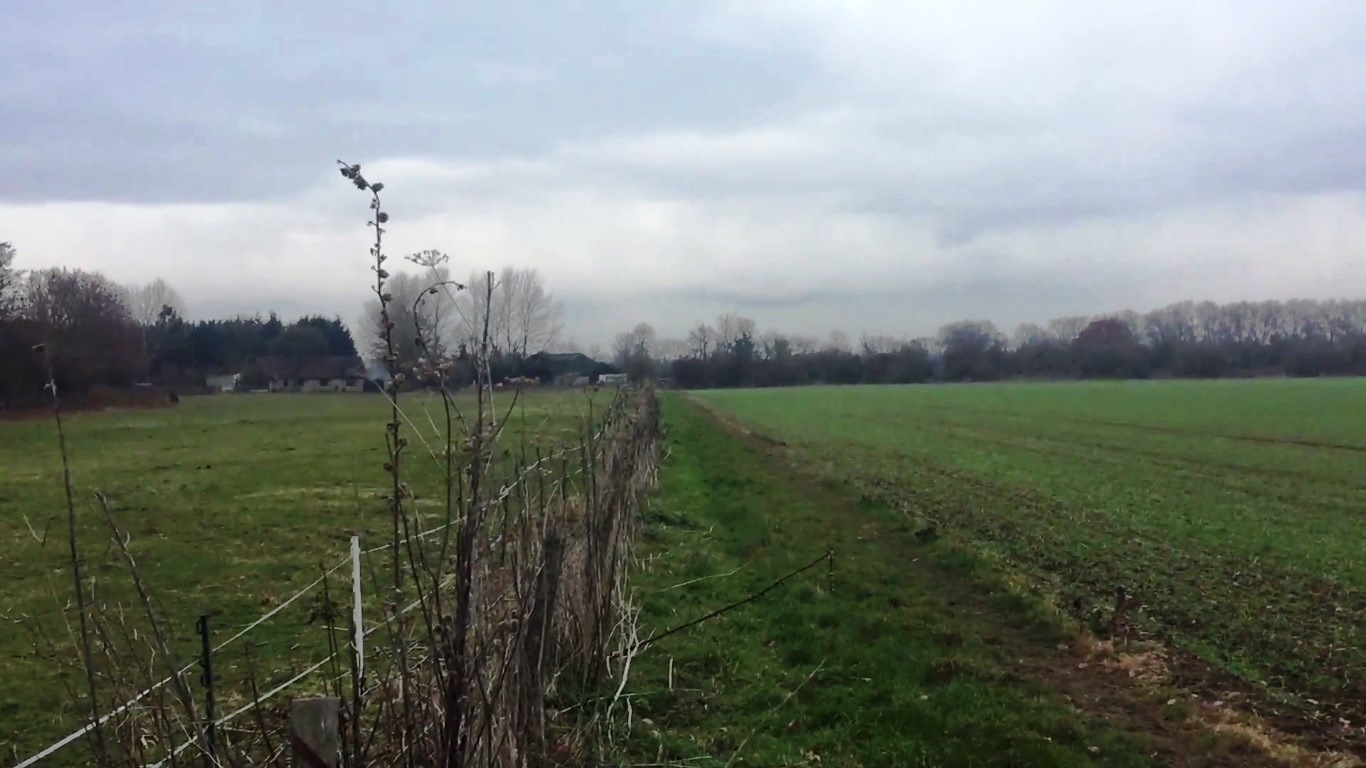Hi there, here is part two of my original post containing various reception videos for the amazing Tecsun PL-310ET pocket shortwave receiver. I continue to be amazed at the sensitivity and selectivity of this rather modest and diminutive receiver, particularly at it’s price-point of around £40 in the UK and less elsewhere! Here is the second half of the reception videos, with some nice signals from Brazil, Guinea, Ethiopia, Swaziland and India. You might notice that some of these catches involve the use of a 240 metre (approx.) length of barbed wire fence! I’m not sure how beneficial the electrical properties of the fence were, probably somewhere between not great and not good lol, but some pretty decent DX was had with the PL-310ET attached to it via the external antenna socket and a crocodile clip!
The barbed wire fence extends almost to the treeline on the horizon; about 240 metres
I hope you enjoy this set of reception videos, they certainly help to demonstrate the great performance of the PL-310ET and in addition of course, it’s ability to handle large antennas quite well. Embedded videos and text links follow below. Lastly, there are now approaching 1,200 reception videos on my YouTube channel Oxford Shortwave Log and I would like to take this additional opportunity to thank everyone for their support, friendship and advice. In the meantime, I wish you all a very Merry Christmas, a Happy New Year and excellent DX!
- Tecsun PL-310ET: TWR Africa 9500 kHz, Manzini, Swaziland, wonderful reception!
- Tecsun PL-310ET: Radio Publique Africaine 11550 kHz, Talata-Volonondry, Madagascar
- Tecsun PL-310ET: Radio Nacional Brasilia 11780 kHz, early evening reception
- Tecsun PL-310ET + 240 metre barbed wire fence = 100 signals detected
- Tecsun PL-310ET first test: Radio Guinée 9650 kHz Conakry, Guinea
- Tecsun PL-310ET: AIR Jeypore 5040 kHz, India, via 240 metre barbed wire fence
- Tecsun PL-310ET first test: Radio Fana 6110 kHz, Addis Ababa, Ethiopia
- Tecsun PL-310ET: Bangladesh Betar closing down 4750 kHz via a 240 m barbed wire fence
Clint Gouveia is the author of this post and a regular contributor to the SWLing Post. Clint actively publishes videos of his shortwave radio excursions on his YouTube channel: Oxford Shortwave Log. Clint is based in Oxfordshire, England.



The radio is sensitive enough But the Heavy AGC is extremely annoying. Over reactive AGC makes it sound like the front end is being overdriven. Tecsun should have put an RF control on it.
I find the little Tecsun hard to replace. Unless you want SSB and Airband this is a great fun radio along woth the help of cheap external wire antennas. On a good night and a few meters of wire I can explore the worlds opinions music Free. Long live Shortwave!.
Have to admith I’m in full agreement with that G.G.
My PL-310ET is a seriously good little receiver with very little to criticise at the price-point.
From your partner Amazon about the PL310ET :
Special design of SSB demodulation functions, can receive amateur maritime communications and personal radio.
What’s that ?
how is it for am dxing
Can I recently say thats a relief to uncover somebody who actually knows what theyre preaching about over the internet. You actually learn how to bring a problem to light and work out it critical. The diet need to read this and understand why side of your story. I cant think youre less well-known since you absolutely provide the gift.
I found that if you TURN OFF PL-310ET dial lamp, the battery would last so longer !
How can I tune in 520-1710 kHz (MW) ? I can only tune in between 522-1620 kHz. LW was initially OFF, then I make it ON according to their mini user’s guide as well as setup FM frequency range from 64-108 mHz.
Thanks in advance.
Tecsun is listening to us. Look at the “0” key beep on/off. Now you don’t have to take the radio apart and with a wire cutters clip off one of the wires to the piezo tweeter to silence it. I have done this too so many radios I have.
Hi Clint,
Very good testing of the PL-310ET. I wonder how it works in a crowded city. I have a PL-380, a very sensitive, selective receiver but subject to local QRM such as tvi, computers, etc.
I also noticed something that also happens with other Tecsun DSP receivers: you moved up 1KHz to avoid strong interference from an adjacent station while tuning Radio Guinea on 9650KHz and the audio dropped down drastically. The same happens with my PL-505. I guess the best method is to narrow the band, which by the way improve DSP performance.
While tuning Radio Publique Afrcaine on 11550Khz, I notice DSP engaging and disengaging due to fading. It happens when the signal drops under and than goes up the threshold of DSP.
DSP can help a lot making the audio clear and improve its quality, but it is also a problem under QSB or when you want to atennuate RF gain so that AVC stabilizes audio.
Thanks for your review. I’m thinking of buying this little wonder, although I still have to use more my PL-505 to determine how different they are, because so far their performances seem very similar to me.
73
Julio Cesar Pereira
Porto Alegre-RS, Brasil
Hi Julio Cesar, thank you for your comments. The Pl-310ET is a fantastic receiver for the price and the audio filters work well, however, below 3 kHz, I sometimes find the audio quite muffled except with stronger signals, thus sometimes, overall audio quality is better if you detune by 1 kHz and retain the wider filter. As regards the DSP engaging and disengaging, you’re absolutely right and this can, of course, affect audio strength and quality. I first noticed this with my PL-680; it happened to me several times whilst recording SW and MW stations during my trip to Brazil, so certainly an idiosyncracy in DSP receivers to watch out for. I have received many messages since I started uploading reception videos of my tests with the PL-310ET, some of which were simply to say they had decided to buy this radio. On the back of my limited experience with it, I would have to respond with a resounding ‘yes’! You won’t be disappointed if you do decide to go ahead and purchase one. Best wishes for the holidays and 73! Clint
I loved the barbed wire fence idea. Last summer I set out in search of “found” shortwave antennas. The first thing I looked for was a long stretch of barbed wire fence. Unfortunately , ranchers in Northern California gave up on wooden post fences some seventy years iago in favor of steel T-posts for barbed wire. The wires on these fences are effectively grounded and make poor antennas. Steel wire does not conduct electricity as well as copper. I could not find a surviving fence of useful length without T-posts.
I had some luck in finding a long stretch of abandoned telegraph or signal wire running alongside an active rail line. I found an ungrounded section over 7000 feet in length (2,100 meters)! This wire was rusting zinc coated steel so I needed to sand a couple of inches before making a connection to the radio. Alas, lossy steel wire and and dead grounds on both ends of this found anttenna provided mediocre performance . That 2100 meter antenna didn’t work as well as my 100 foot backyard random wire.
I may return to the telegraph line antenna for another try, but technically that would be trespassing on railroad property. I can see some astonished engineer calling the local cops on me.
Hi Dan, interesting story! There are so many wire and barbed wire fences in rural Oxforshire that all I need to carry is a cable with a 3.5 mm plug on one end and a crocodile clip on the other! Fortunately wooden support posts are far more common where I live, thus there are usually lots of antenna options when out walking the dog! Cheers, Clint
I used my car for an antenna by parking it on 4 sheets of lexan. A transmatch is needed to match the highly capacitive load. It does not work any better than a 20 foot length of wire.
I use a similar antenna connector for my radios. It is several feet of stranded copper wire with a soldered 1/8″ plug on one end and a clip on the other. The clip looks like a miniature version of the clips used for automotive jumper cables. These have a stonger bite than alligator clips. I often pack this connector along with a radio and spool-up antenna while traveling.
whhaaaaaghhhhhhhhhh my pl-380 is no longer brilliant!